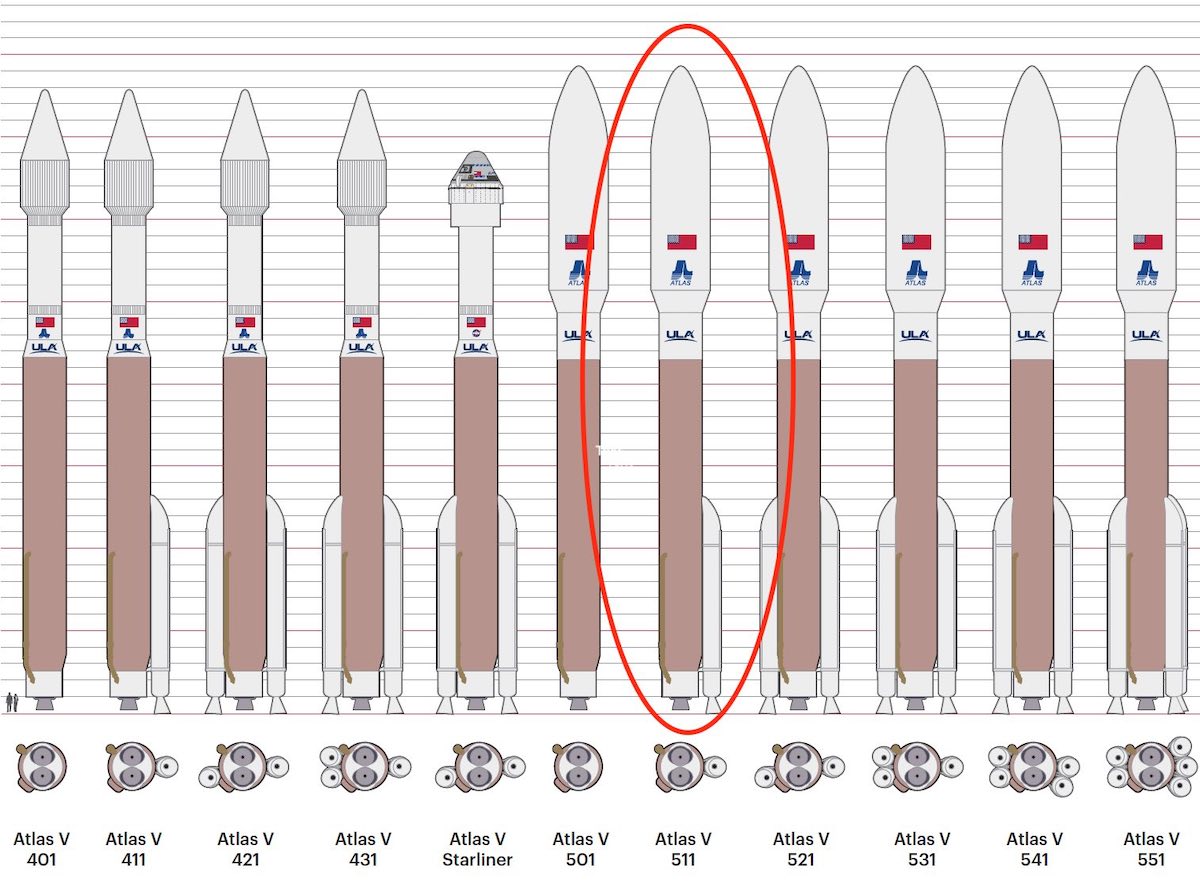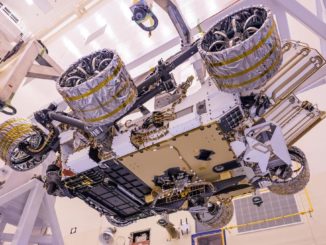
The last unflown variant of United Launch Alliance’s Atlas 5 launcher — fitted with a five-meter fairing and a single strap-on solid rocket booster — will carry a pair of U.S. military space surveillance satellites toward geosynchronous orbit from Cape Canaveral late this year, according to a Space Force spokesperson.
Atlas 5 rockets have flown 82 missions since August 2002, but none have launched in the Atlas 5’s “511” configuration with a 5.4-meter-diameter (17.7-foot) payload fairing and a single solid-fueled motor providing an additional boost during the first 90 seconds of flight.
That will change with the launch of the next pair of satellites for the Space Force’s Geosynchronous Space Situational Awareness Program. Built by Northrop Grumman, the satellites are designed to help the military track and observe objects in geosynchronous orbit more than 22,000 miles (nearly 36,000 kilometers) over the equator.
The GSSAP 5 and 6 satellites launching on the Atlas 5-511 rocket will join four others deployed by two Delta 4 rockets in 2014 and 2016.
The Atlas 5-511 rocket will take off with 1.2 million pounds of thrust from the single solid-fueled booster and the first stage’s kerosene-fueled RD-180 main engine. According to ULA, the Atlas 5-511 can carry up to 11,570 pounds (5,250 kilograms) to an elliptical geostationary transfer orbit. Its capacity to low Earth orbit is roughly 24,250 pounds (11,000 kilograms), according to ULA performance data.
The Atlas 5 rocket was designed by Lockheed Martin to fly in up to 20 different configurations, giving engineers the ability to “dial” the rocket’s power and payload volume to meet the needs of each specific mission. Mission planners have the option of flying a four-meter or five-meter diameter payload fairing, and can fly the Atlas 5 with up to five strap-on solid boosters, or none if the mission doesn’t need them.
The Atlas 5’s Centaur upper stage can fly with one or two RL10 engines, depending on mission requirements. So far, all but one Atlas 5 launch has flown with the single-engine Centaur upper stage.
The exception is on launches with Boeing’s Starliner capsule, which launches with a dual-engine Centaur stage. There are no other missions on the Atlas 5 launch schedule using the dual-engine Centaur stage.
The addition of the unique Atlas 5 configuration for Starliner missions and the lack of use of other dual-engine Centaur variants effective leaves 11 Atlas 5 versions that will have flown at least once before the rocket’s retirement in the coming years. ULA is developing the upgraded Vulcan Centaur rocket to replace the Atlas and Delta rocket families.
The most-used version of the Atlas 5 to date is the “401” variant with a four-meter fairing and no solid boosters. The Atlas 5-401 has flown 38 times, including the first Atlas flight in 2002.
Lockheed Martin merged its Atlas rocket program with Boeing’s Delta family in 2006 to create United Launch Alliance.
ULA has around around Atlas 5 missions planned this year — all from Cape Canaveral — including the successful launch of the Solar Orbiter mission Sunday night for the European Space Agency and NASA.
Solar Orbiter used the “411” variant of the Atlas 5 rocket with a four-meter (13.1-foot) payload shroud and a single strap-on solid-fueled booster. The Atlas 5-411 configuration has launched six times to date.
With asymmetrical thrust countered by steering from the Atlas 5’s RD-180 main engine, the Atlas 5-511 and -411 configurations are unique among launchers currently in service. The ability to add a single booster allows customers to pay for just enough capacity for their payloads, rather than buying a more larger, more expensive Atlas 5 variant.
Other Atlas 5 flights scheduled in 2020 include the launch of the Space Force’s sixth Advanced Extremely High Frequency communications satellite on the most powerful Atlas 5 version — the 551 with a five-meter fairing and five boosters — no earlier than March 13. A flight with the Space Force’s X-37B spaceplane is scheduled for May using an Atlas 5-501 with a five-meter fairing and no strap-on motors
The launch of NASA’s Mars 2020 rover is planned in July on an Atlas 5-541 with a five-meter fairing and four solid rocket boosters.
Later this year, a classified payload for the National Reconnaissance Office — the U.S. government’s spy satellite agency — will lift off on an Atlas 5-531 rocket with a five-meter fairing and three solid-fueled augmentation motors in the August or September timeframe. That mission is designated NROL-101.
Then an Atlas 5 rocket will launch the GSSAP 5 and 6 satellites in the fourth quarter of 2020 — between the beginning of October and the end of December — on a mission designated AFSPC-8.
Atlas 5 rocket hardware for the first piloted test flight of Boeing’s Starliner crew capsule is also in storage at Cape Canaveral for a possible launch some time this year. But Boeing and NASA are investigating software errors that plagued the Starliner’s first unpiloted orbital test flight in December, and officials have not decided whether Boeing must perform another demonstration flight without astronauts before proceeding with a crewed launch.
Starliner missions fly on a special variant of the Atlas 5 without a payload shroud. Two solid rocket boosters are mounted on the first stage to give the Starliner and extra boost into space, and the Atlas 5’s Centaur upper stage is fitted with two RL10 engines instead of one.
Email the author.
Follow Stephen Clark on Twitter: @StephenClark1.



